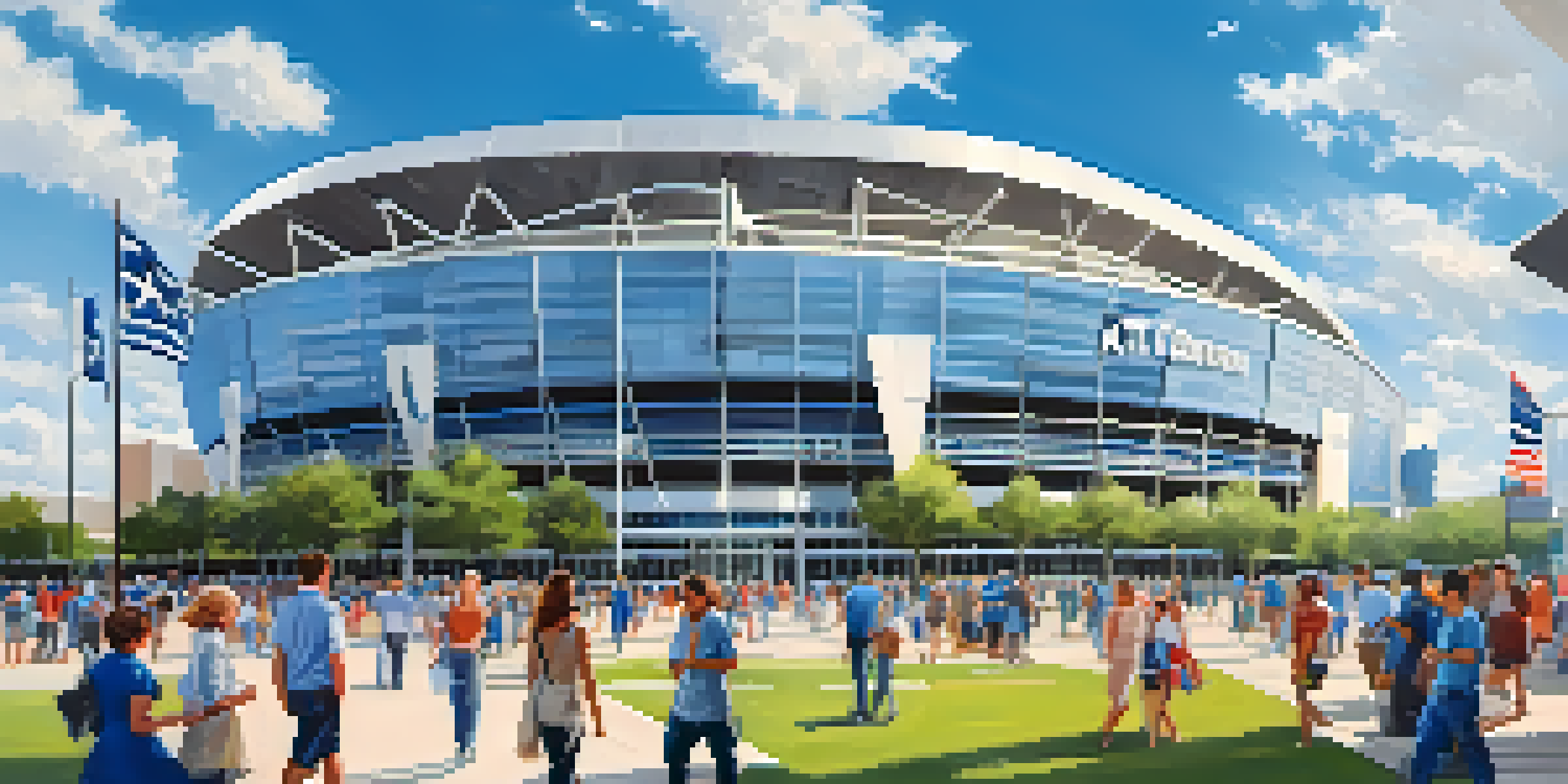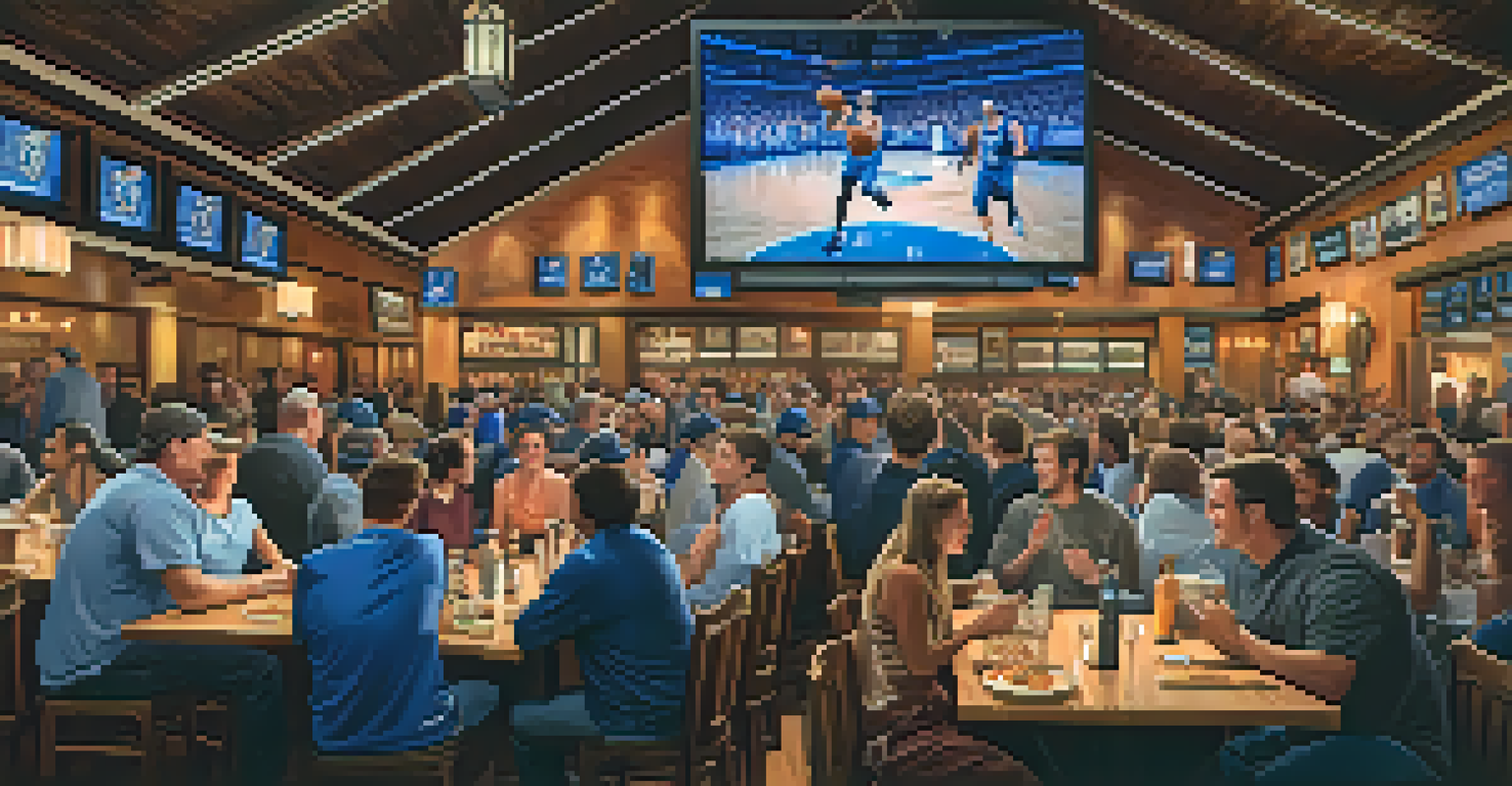The Role of Sports Facilities in Dallas’s Economic Growth

Introduction to Dallas's Sports Facilities and Economy
Dallas is a city known for its vibrant sports culture, with facilities that attract fans and athletes alike. The presence of major venues like AT&T Stadium and the American Airlines Center not only caters to sports enthusiasts but also serves as a cornerstone for the local economy. The interplay between sports facilities and economic growth is profound, influencing various sectors from hospitality to retail.
Sports facilities are not just places to play; they are vital economic engines that can drive growth and create community connections.
These facilities are not just places to watch games; they are multifaceted hubs that host concerts, community events, and conventions, drawing in visitors year-round. This influx of visitors creates jobs and stimulates spending, which in turn fuels the economic ecosystem of the city. As Dallas continues to invest in its sports infrastructure, the potential for growth remains significant.
In this article, we will explore the various ways in which sports facilities contribute to Dallas's economic development, creating opportunities for businesses and enhancing the overall quality of life for its residents.
Job Creation Linked to Sports Facilities
One of the most direct impacts of sports facilities on the economy is job creation. When a new stadium or arena is built, it not only requires construction jobs but also generates a demand for ongoing operational staff. From event coordinators to maintenance crews, these venues create diverse employment opportunities that benefit the local workforce.

Moreover, the events held at these facilities attract thousands of visitors, necessitating additional services such as security, ticketing, and concessions. Local businesses, including hotels and restaurants, also thrive on the increased foot traffic, leading to further job creation in these sectors. In essence, sports facilities serve as catalysts for job growth within the community.
Job Creation Through Sports Facilities
Sports facilities in Dallas create diverse job opportunities, benefiting the local workforce through construction and ongoing operational roles.
The ripple effect is clear: as jobs increase around these venues, so does the overall spending power of residents. This economic activity translates into a stronger community and a more resilient local economy.
Boosting Local Businesses Through Sports Events
Sports facilities play a crucial role in boosting local businesses, particularly in hospitality and retail. When major sporting events take place, nearby restaurants, bars, and shops see a significant uptick in sales. Fans flock to these establishments before and after games, creating a vibrant atmosphere that benefits everyone.
Investing in sports infrastructure is investing in the community's future, with benefits that extend far beyond the stadium.
For instance, during Dallas Cowboys games, the surrounding area experiences a surge in customers seeking food, drinks, and merchandise. This not only helps local businesses thrive but also fosters a sense of community as fans gather to celebrate their teams. Events at sports facilities often encourage partnerships between local businesses and the venues themselves, leading to special promotions and collaborations.
As a result, the economic impact of sports facilities extends beyond the venues themselves, creating a network of support for local entrepreneurs and contributing to a robust local economy.
Attracting Tourism and Major Events
Dallas's sports facilities are instrumental in attracting tourism and hosting major events. High-profile games, tournaments, and championships draw visitors from across the country and beyond. This influx not only boosts hotel occupancy rates but also fills restaurants, shops, and attractions throughout the city.
For example, the Super Bowl and NCAA Final Four have graced Dallas, showcasing the city on a national stage and bringing in millions of dollars in tourism revenue. The ability to host such significant events is a testament to the city's investment in its sports infrastructure and its commitment to promoting economic growth.
Boosting Local Businesses
Major sporting events significantly increase sales for nearby restaurants and shops, fostering a sense of community and economic growth.
Tourism driven by sports facilities also promotes a positive image of Dallas, encouraging further investments in the community. As more visitors discover the city's offerings, the potential for economic expansion continues to grow.
Enhancing Community Engagement and Quality of Life
Beyond economic metrics, sports facilities in Dallas play a vital role in enhancing community engagement. They serve as gathering places for local residents, fostering a sense of pride and identity. Community events, youth sports leagues, and public activities held at these venues promote inclusivity and bring people together.
Moreover, the presence of sports facilities often leads to the development of surrounding parks and recreational areas, enhancing the quality of life for residents. Families can enjoy a variety of activities, from enjoying a game to participating in health and fitness programs. This interconnectedness helps build a strong community spirit.
In this way, sports facilities contribute to a holistic approach to community development, where economic growth and social engagement go hand in hand.
Investment in Infrastructure and Urban Development
The construction and maintenance of sports facilities often lead to broader investments in urban infrastructure. Roads, public transport, and utilities tend to receive upgrades to support the increased activity around these venues. This not only enhances accessibility for fans but also benefits local residents who utilize these improved services.
As neighborhoods around sports facilities develop, property values often rise, leading to increased tax revenues for the city. These funds can then be reinvested into community services, schools, and public amenities, creating a cycle of growth and improvement. The transformation of urban spaces can also attract new businesses and residents, further diversifying the local economy.
Tourism and Major Events Impact
High-profile sports events attract visitors, boosting tourism revenue and enhancing Dallas's image as a premier destination.
Ultimately, investment in sports facilities is a catalyst for comprehensive urban development, shaping the future of Dallas as a dynamic and vibrant city.
Sustainability Initiatives in Sports Facilities
In recent years, many sports facilities in Dallas have embraced sustainability initiatives, recognizing their role in environmental responsibility. From energy-efficient designs to waste reduction programs, venues are increasingly focusing on minimizing their ecological footprints. This commitment to sustainability not only appeals to environmentally-conscious fans but also sets a standard for the community.
By implementing green practices, these facilities can reduce operational costs, which can be redirected towards community programs and improvements. Moreover, this focus on sustainability can attract environmentally-focused events, further enhancing the economic benefits of the venues.

As Dallas continues to grow, the emphasis on sustainable development within sports facilities will play a crucial role in ensuring a healthier environment for future generations while also contributing positively to the economy.
Conclusion: A Win-Win for Dallas
In conclusion, the role of sports facilities in Dallas’s economic growth cannot be overstated. They not only create jobs and boost local businesses but also enhance community engagement and urban development. The investment in these venues is an investment in the future of Dallas, fostering a vibrant economy and an engaged community.
As the city continues to evolve, the synergy between sports and economic growth will likely deepen, paving the way for new opportunities and innovations. With ongoing commitment from local leaders and stakeholders, Dallas can harness the full potential of its sports facilities.
Ultimately, the relationship between sports facilities and economic growth exemplifies how investing in community assets can yield significant returns, creating a win-win situation for all involved.